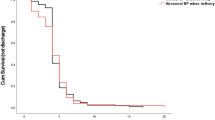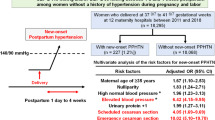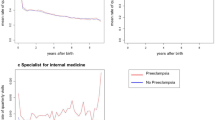Abstract
Objective:
To evaluate the association between mode of delivery and length of labor on readmission for postpartum hypertension in women with pregnancy-related hypertension.
Study Design:
Nested case control study within a cohort of 99 women with pregnancy-related hypertension who delivered at our institution between 2005 and 2009. Data were abstracted for clinical and labor information. Mode of delivery and length of labor were compared between women with previously diagnosed pregnancy-related hypertension readmitted within 4 weeks post partum (25 cases) and those not readmitted (74 controls). Categorical and continuous variables were compared using χ2 and T-tests, respectively. Multivariable logistic regression controlled for confounders.
Result:
Hypertension readmission was not associated with mode of delivery (cases: 10(40%) spontaneous vaginal delivery, 15(60%) cesarean delivery; controls: 38(51%) spontaneous vaginal delivery, 36(49%) cesarean delivery, P=0.33). Length of labor appeared longer in cases, with a trend toward significance (median: 15.5 [7,28] h vs 10.75 [5.8,15.9] h, P=0.12) and was significantly associated with readmission after controlling for delivery mode, induction and parity (adjusted odds ratio=1.06 [1 to 1.12], P=0.048). Readmitted patients were less likely to have initially been started on antihypertensive medications after controlling for age, race and chronic hypertension (adjusted odds ratio=0.23 [0.06 to 0.88], P=0.03).
Conclusion:
Postpartum readmission for hypertension in women with known pregnancy-related hypertension is not associated with mode of delivery, appears increased in those with longer length of labor and decreased in those initially started on antihypertensive medications. This provides targets for future research to continue to improve transitions of care and reduce preventable readmissions.
This is a preview of subscription content, access via your institution
Access options
Subscribe to this journal
Receive 12 print issues and online access
$259.00 per year
only $21.58 per issue
Buy this article
- Purchase on Springer Link
- Instant access to full article PDF
Prices may be subject to local taxes which are calculated during checkout
Similar content being viewed by others
References
American Hospital Association. Reducing Avoidable Obstetrical and Neonatal Readmissions. Available from http://www.aha.org/content/11/PerinatalReadmissionscall1.pdf (Retrieved 20 February 2014).
American College of Obstetricians and Gynecologists, Task Force on Hypertension in Pregnancy. Report of the American College of Obstetricians and Gynecologists’ Task Force on Hypertension in Pregnancy. Obstet Gynecol 2013; 122 (5): 1122–1131.
Matthys LA, Coppage KH, Lambers DS, Barton JR, Sibai BM . Delayed postpartum preeclampsia: an experience of 151 cases. Am J Obstet Gynecol 2004; 190: 1464–1466.
Walters BN, Walters T . Hypertension in the puerperium. Lancet 1987; 2: 330.
Sibai BM . Etiology and management of postpartum hypertension-preeclampsia. Am J Obstet Gynecol 2012; 206 (6): 470–475.
Berks D, Steegers EA, Molas M, Visser W . Resolution of hypertension and proteinuria after preeclampsia. Obstet Gynecol 2009; 114 (6): 1307–1314.
Srinivas SK, Morrison AC, Andrela C, Elovitz MA . Allelic variations in angiogenic pathway genes are associated with preeclampsia. Am J Obstet Gynecol 2010; 202 (5): 445.e1–11.
Mazar RM, Srinivas SK, Sammel MD, Andrela CM, Elovitz MA . Metabolic score as a novel approach to assessing preeclampsia. Am J Obstet Gynecol 2007; 197 (4): 411.e1–411.e5.
ACOG Committee on Practice Bulletins—Obstetrics. ACOG Practice Bulletin No. 33. Diagnosis and management of preeclampsia and eclampsia. Obstet Gynecol 2002; 99: 159–167.
Atterbury JL, Groome LJ, Hoff C, Yarnell JA . Clinical presentation of women readmitted with postpartum severe preeclampsia or eclampsia. J Obstet Gynecol Neonatal Nurs 1998; 27: 134–141.
Chames MC, Livingston JC, Ivester TS, Barton JR, Sibai BM . Late postpartum eclampsia: a preventable disease? Am J Obstet Gynecol 2002; 186: 1174–1177.
Larsen WI, Strong JE, Farley JH . Risk factors for late postpartum preeclampsia. J Reprod Med 2012; 57: 35–38.
Yancey LM, Withers E, Bakes K, Abott J . Postpartum preeclampsia: emergency department presentation and management. J Emerg Med 2001; 40 (4): 380–384.
Ascarelli MH, Johnson V, McCreary H, Cushman J, May WL, Martin JN . Postpartum preeclampsia management with furosemide: a randomized clinical trial. Am J Obstet Gynecol 2005; 105 (1): 29–33.
D’Alton ME, Bonanno CA, Berkowitz RL, Brown HL, Copel JA, Cunningham FG et al. Putting the “M” back in maternal-fetal medicine. Am J Obstet Gynecol 2013; 208 (6): 442–448.
Acknowledgements
Poster (#374) entitled ‘Do clinical factors predict hypertension-related readmissions in women with preeclampsia?’ was presented at the 34th Annual Meeting of the Society for Maternal-Fetal Medicine in New Orleans, Louisiana on February 3 to 8, 2014.
Author information
Authors and Affiliations
Corresponding author
Ethics declarations
Competing interests
The authors declare no conflict of interest.
Rights and permissions
About this article
Cite this article
Hirshberg, A., Levine, L. & Srinivas, S. Clinical factors associated with readmission for postpartum hypertension in women with pregnancy-related hypertension: a nested case control study. J Perinatol 36, 405–409 (2016). https://doi.org/10.1038/jp.2015.209
Received:
Revised:
Accepted:
Published:
Issue Date:
DOI: https://doi.org/10.1038/jp.2015.209
This article is cited by
-
Best Practices for Managing Postpartum Hypertension
Current Obstetrics and Gynecology Reports (2022)



